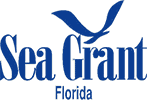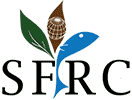Home » Projects » Shellfish Aquaculture Production and Management Projects » Preliminary Health Assessment of Florida Cultured Clams

Shellfish farming in Florida is currently dependent on monoculture of one species — hard clams. One of the risks of monoculture is the potential for large losses following the appearance of a disease-causing agent. At present, disease does not seem to be an issue for Florida clam growers. However, it is prudent to initiate a program in shellfish pathology and develop diagnostic expertise in the state.
The goal of this study was to establish a health monitoring program for cultured clams in Florida to serve as a preliminary baseline for pathological changes in Mercenaria mercenaria. Three growing sites in the state were selected for monitoring clams. Sites included the northwest Gulf of Mexico coast (Gulf Jackson High-density Lease Area in the Gulf of Mexico near Cedar Key), central east Atlantic coast (Indian River Aquaculture Use Zone in the Indian River near Sebastian), and the southwest Gulf of Mexico coast (winter collection: Sandfly Key High-density Lease Area in Charlotte Harbor near Placida; summer collection: South Pine Island High-density Lease Area in Pine Island Sound near St. James City). Samples from all sites were collected seasonally, winter and summer, for one year. The winter collection samples were taken in February 2003 and summer collections in August 2003. All clams tested were market size animals – 1” shell width, or thick. Sixty clams were collected from the three sites during each of the two sampling periods. Live clams were packaged in insulated shipping boxes with gel packs and shipped overnight to the University of Florida. On arrival the clams were measured and numbered. Half the clams from each collection site were shucked and placed whole into 10% buffered formalin with seawater for preparation for histological evaluation. The other half were shucked and sections of mantle and digestive gland were placed in Ray’s fluid thioglycollate media and incubated for culture of Perkinsus species.
Clams have relatively few recognized or significant diseases as compared to other bivalve mollusks. QPX is the only disease known at this time that is infectious for clams only. However, clams are susceptible to bacterial diseases, and to parasites, such as copepods, trematodes, nemerteans, and cestodes. Protozoans have been implicated as a cause of disease in cultured clams, and appear to be secondary to stressors such as high stocking density and poor water quality. Some of these may be considered incidental findings.
In the group of clams examined, granulomas were the most frequently observed abnormalities, followed by Rickettsiales like organisms, non-granulomatous inflammation, metazoans and concretions in the kidney. Granulomas occur when the clam responds to a foreign body with chronic inflammation. Frequently, the source of the inflammation is a trematode (flatworm), or other metazoan parasite (see picture). The SW Florida clams, regardless of season, were more affected than clams from other collection sites. However, clams from all sites and seasons were affected. Metazoan parasites were observed in some granulomas.
Rickettsia and Chlamydia are bacteria that can only live inside cells. They may either be harmless or agents of disease. Rickettsiales-like organisms (RLO) and Chlamydiales-like organisms (CLO) are not uncommon findings in bivalve mollusks. RLO are typically found in the gills and CLO are usually found in the digestive gland. Their presence has infrequently been associated with mortality and primarily in culture situations (high density, crowding, etc.). RLO were observed in the gills of the winter clams from all sites. Only summer clams from the Indian River had RLO in the gills. Where RLO were present in clams, adjacent gill inflammation was infrequently observed. It is unclear if the RLO are a significant problem for clams. No CLO were observed in any clam samples.
Non-granulomatous inflammation occurs when an animal responds to non-specific injury. An inflammatory response is typically classified as acute or chronic, but this was not determined in the group of clams examined. Non-granulomatous inflammation was observed in 66% of the winter clams from the SW Florida area, with much less observed in clams from other sampling sites. The source(s) of the non-granulomatous inflammation was not determined. A concretion is a stone or inorganic mass in a natural cavity or tissue. Concretions were observed in the kidneys of clams from all collection sites except for the winter clams from SW Florida; however, the overall number of affected animals was low.
Although clams do not develop disease from Perkinsus, or Dermo, they can serve as a source for the parasite, which means that infected clams have the potential to move Perkinsus from one geographic area to another. In Florida, live shellfish can only be relayed within specific geographic regions. Oysters are susceptible to Perkinsus marinus infection. When Perkinsus is seen in clams, it is indicative of an adjacent population of infected oysters. Perkinsus was identified in clams from all three study sites tested during this study. With the exception of one animal collected in SW Florida, all Perkinsus positive clams were collected during the summer sampling period only. Studies in Florida and other coastal regions have documented an increased incidence of Perkinsus in oysters in late summer. This study confirms the seasonal incidence of Perkinsus in clams.
The most important pathogen of clams is QPX, or Quahog Pathogen Unknown. QPX has had a devastating effect on cultured clams in the northeastern United States. QPX is caused by a single-cell parasite that possesses characteristics of both a fungus and an animal. QPX is thought to be a species-specific disease where it is only infectious and fatal to the hard clam. It is not thought to be a threat to other shellfish, nor is it a threat to human health. QPX was first reported in wild and hatchery stocks of clams in eastern Canada. It now ranges from Canada to Virginia and has resulted in as much as 95% mortality of cultured clams in affected sites. The origin of QPX in waters is currently the subject of scientific debate. At present, the life history of QPX is not known. While it has never been identified in Florida clams, there is concern that it may be introduced. Consequently, imported clam seed are tested and proven free of the QPX agent before entry into the state. Infection with QPX results in an inflammatory response in the clam. This is manifested by nodule formation in the clam mantle that can prevent closure of the valves, and disruption of connective tissue throughout the infected clam. There was no histological or pathological evidence of QPX in cultured clams from the three Florida sites tested in this study.
A presentation on project results was made at a state meeting and can be viewed below in PDF format.
A final report was made available as an Electronic Data Information Source (EDIS) publication and can be viewed below in PDF format or electronically.
University of Florida | IFAS
Shellfish Aquaculture Research & Extension
11350 SW 153rd Court I P.O. Box 89
Cedar Key, FL 32625
Phone: (352) 543-5057


